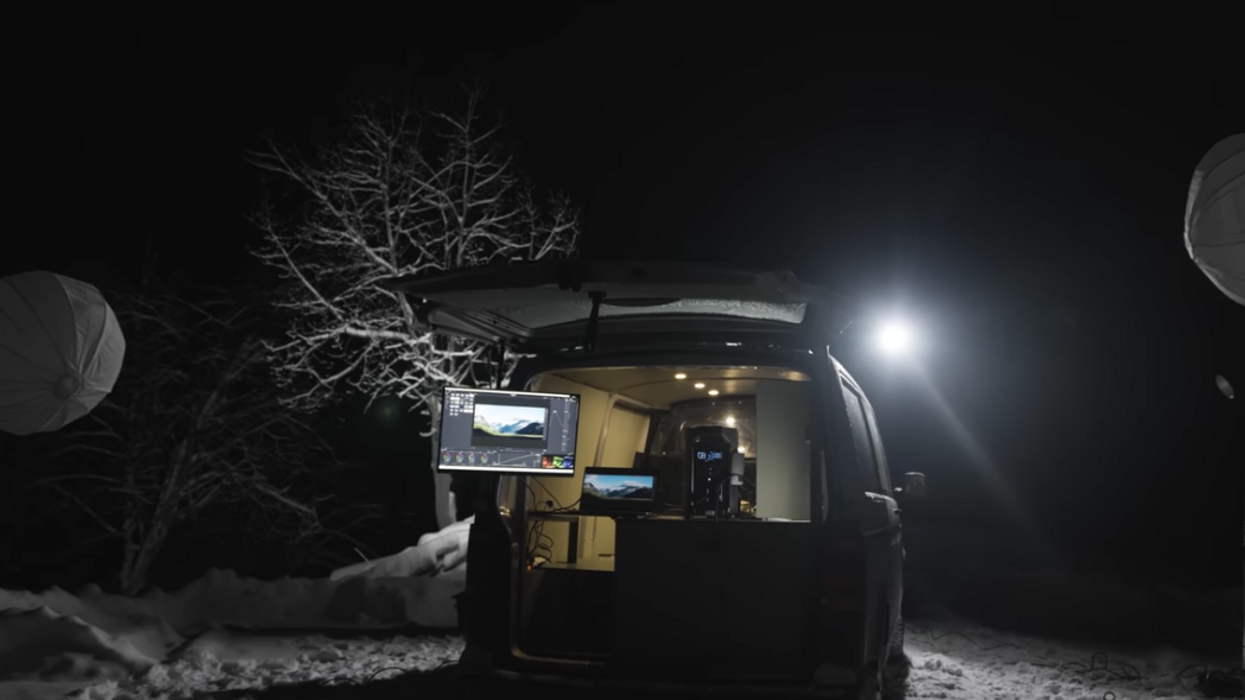Why Building Out Your Own Production Vehicle Is a Great Project Between Gigs
It’s time to build out a projection vehicle, and these Danish filmmakers have the ideal setup.

There are times during the year when you’re in between gigs, and that’s the ideal time to do a project that will not only make your professional life easier but also make you additional income. If you’re charging for a cinema kit anyway, why not have a vehicle that can carry everything you need, and act as your command center while on location?
Check out how this team did it.
This idea comes from Norwegian YouTuber Anders Overguardd (aka Andyvax), who has his own company called VJUS, which he runs with a close-knit group of friends. But between gigs, they wanted to create a custom-designed production vehicle for not only carrying their camera gear and lights but also to provide a steady source of power while on location.
“Last summer we were running from project to project and renting cars several times a week,” said partner Morgan Rustad. “I felt like we were throwing money out the window every time… wouldn’t it be more economical if we got our own used car?”
A Studio on Wheels
After looking at what was available, they got a great deal on a Volkswagen Transporter cargo van and built it out for all their production needs. This cargo van is not only popular with delivery companies but is also a favorite design for the DIY camping van crowd, right along with the Mercedes Sprinter, Ford Transit, or Chevy Express.
Rustad and company took some measurements and began brainstorming the layout. The Transporter had an overall capacity of between 47 and 54 square feet, so there was plenty of room to spare for all their camera gear, lights, and even an editing bay complete with a secondary TV monitor for a director or client to watch the day’s footage. A few digital sketches later, Team VJUS had a working design.
Next came the build. This required gutting the interior and building the cabinets with repurposed materials and some plywood to outfit the cabinets and desk area. He still found room for a kitchen and fridge. Rustad was confident that his skills could save the company money, but not everyone is adept with the tools or knowledge to make cabinets and other furniture.
Moreover, the cost of wood isn’t exactly cheap these days. Thankfully, another Norwegian solution can come to the rescue—IKEA. As long as you have the accurate dimensions of the van you’ve chosen, it’s a safe bet that the furnishings giant could offer a solution that provides a comfortable and professional-looking layout after a weekend of assembly.
The Heartbeat of the System
Rustad also wanted the van to be self-sustainable, capable of powering up a variety of studio lights for an all-day video shoot, while supporting their laptop-based editing system. That’s a lot of power for a long shooting day. Moreover, the design sought to be eco-friendly, which meant that the gang would turn to a combination of solar charging panels and what would end up being the heart of the system: the Ecoflow Delta Pro Power Station.
The Delta Pro is a beast of a power source, with a 3.6 kWh capacity that can be expanded all the way to 25 kWh. It's a total of up to 3600w of power that can surge up to twice that amount. Coupled with an extra smart battery bank to double the capacity and a pair of 400w solar panels, Rustad was confident he found a solution that would give the team enough energy to run their lights all day and even be carbon neutral.
“To put it into perspective,” Rustad said, ”we could run up to 10 Aputure 300ds at full power for two hours.”
That translates into a lot of power without having to have loud, polluting gas generators to keep the lights on. And the Delta Pro recharges in two hours. So plugging them in at lunch or keeping them topped off with the sun’s rays is a great solution.
What Did the Whole Project Cost?
Well, that’s where we have the tried and true phrase, “Your mileage may vary based on your specific production needs and the design of the van’s configuration.” Moreover, Rustad didn’t get into the numbers, which also included some unexpected vehicle repairs. However, we can guesstimate based on the value of the van and a ballpark tally of what it could cost to fit it out can be made.
A used 2017 VW Transporter in the UK would set your company back about $48,000 plus VAT and fees. There’s a lot of wiggle room here based on the model, the year, and its Blue Book value.
Then there’s another $500 to $1,000 in materials to fit out the van with storage, a kitchen, and then about $3,500 for the Delta Pro (although Rustad managed to get Ecoflow to send them a promotional unit for the video).
So at the end of the day, you’re looking at at least $35,000 to $55,000 for a home-built studio production van that can serve as the mobile central hub to light, shoot, and edit without any additional power while on location.
Again, your mileage may vary, and there are a lot of alternative solutions to add or subtract from the final cost. You could also factor in any offsets from tax incentives if the project is done in a green fashion, and you could end up saving even more.
However, as a starting point, it’s not too bad, considering the benefits of expanding your production company’s capabilities while reducing your carbon footprint at the same time. And don’t forget the boost to the value of your camera kit fee.
Would you attempt this project? Let us know.
Source: Andyax











